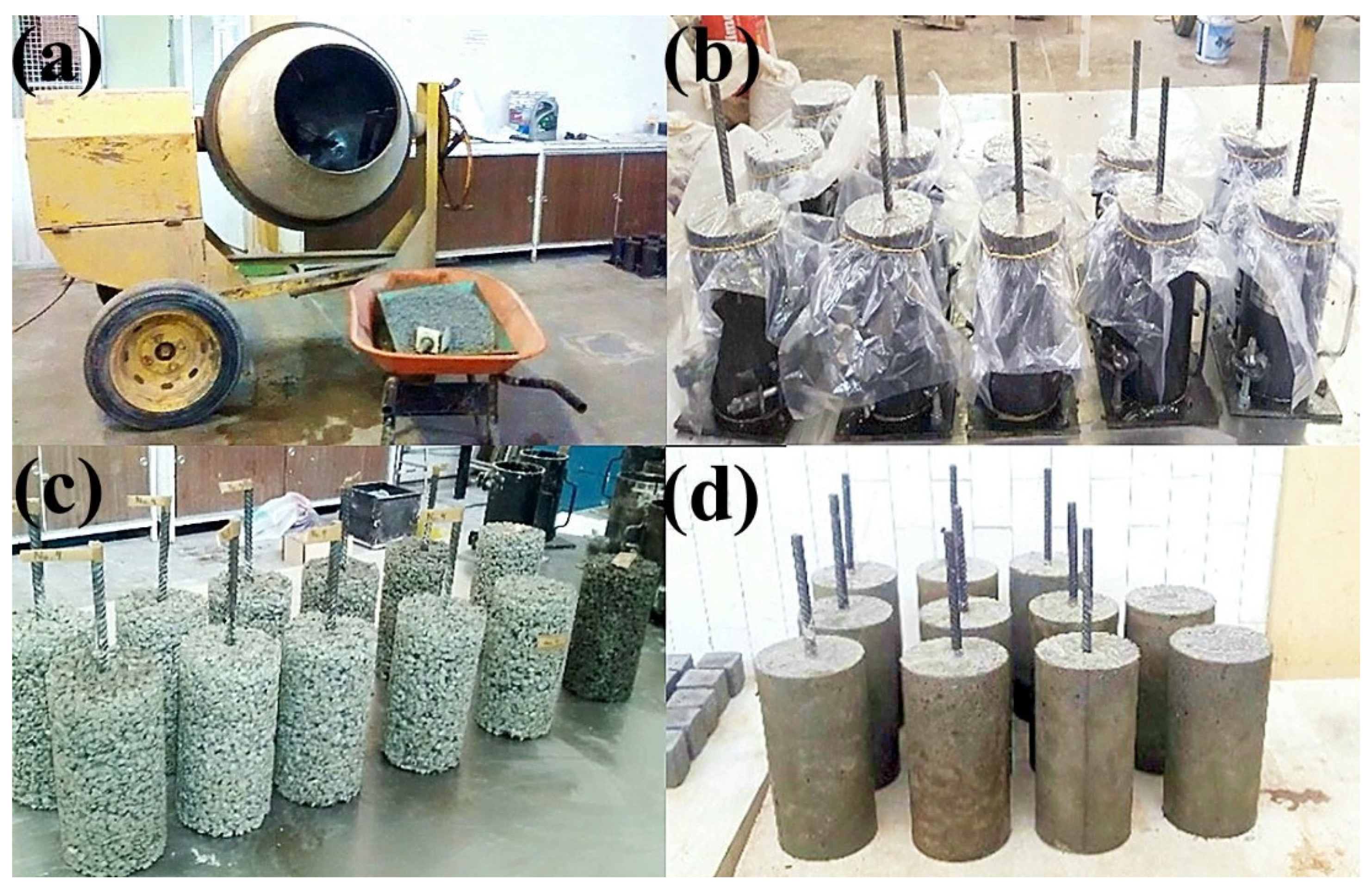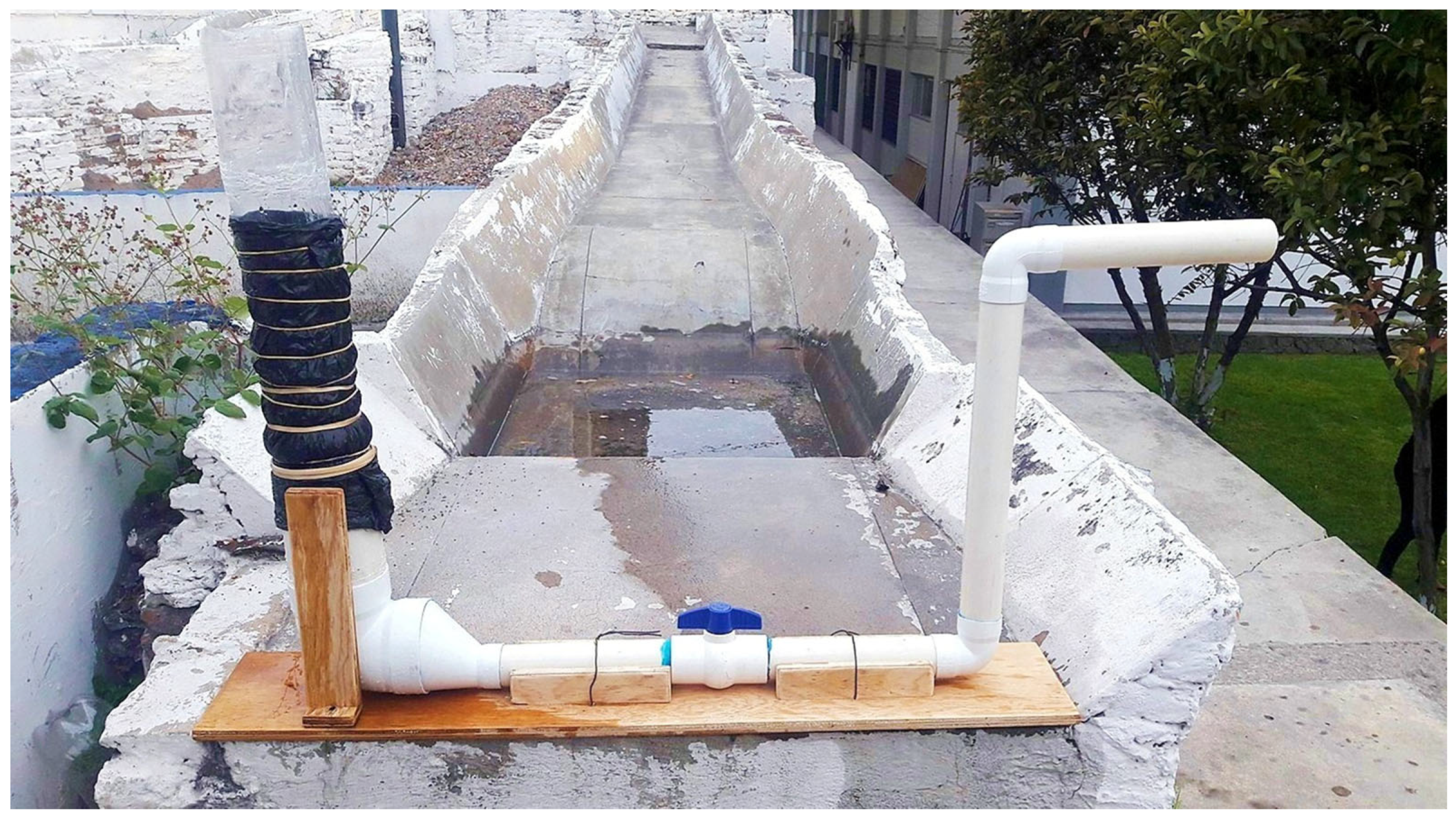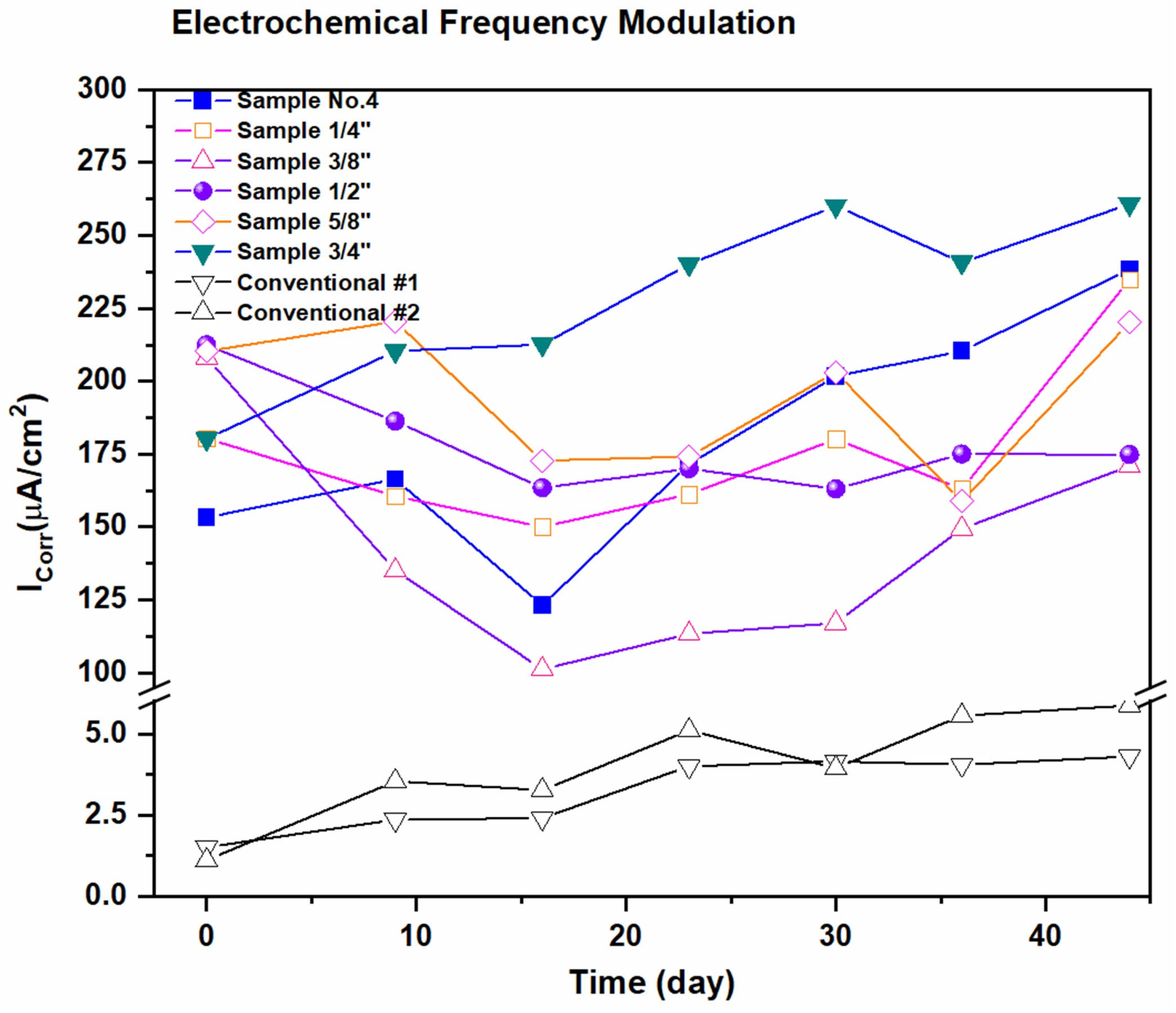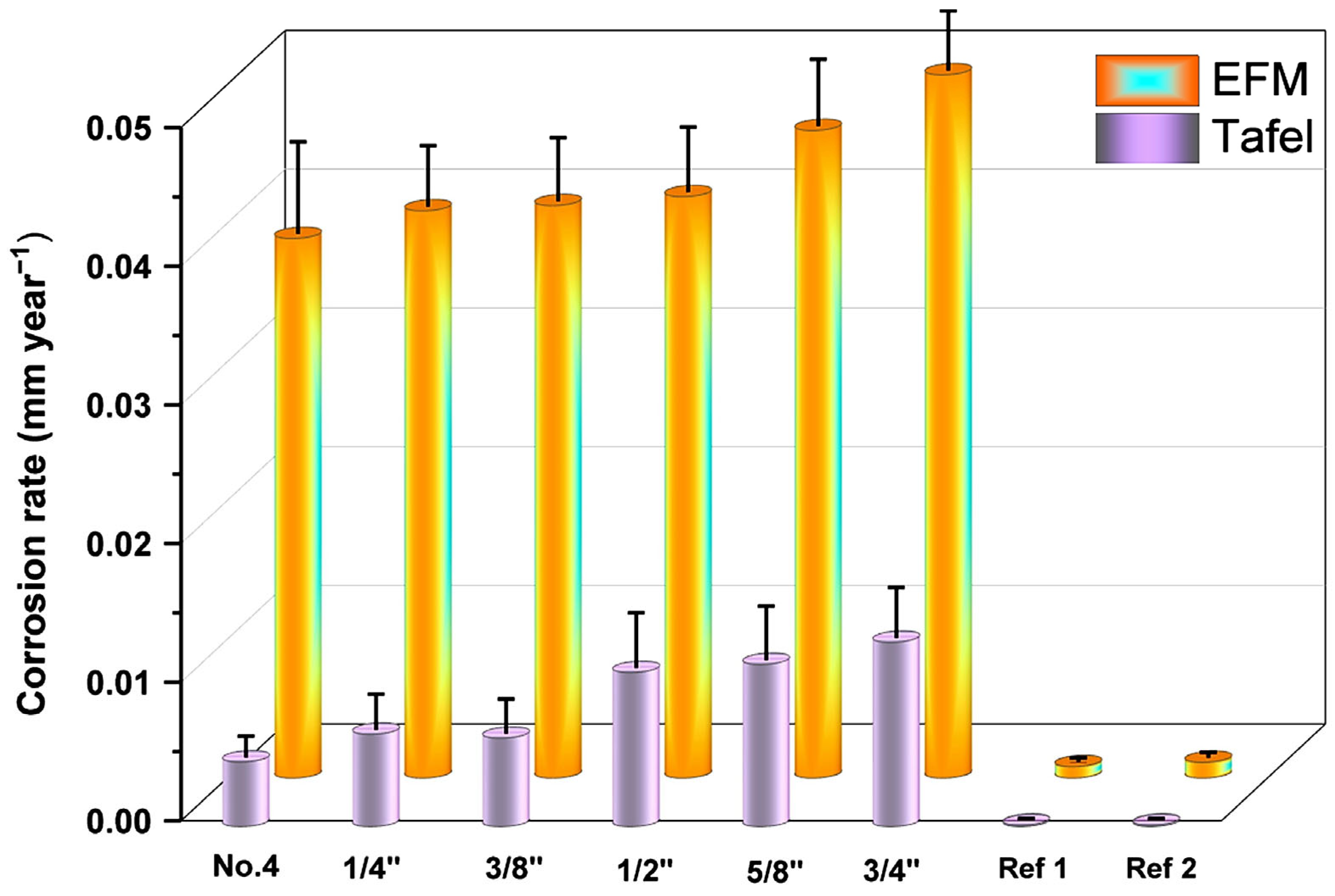Corrosion of Steel Rebars in Construction Materials with Reinforced Pervious Concrete
Abstract
:1. Introduction
2. Experimental
2.1. Design and Elaboration of Concrete Specimens
2.2. Preparation of Cylindrical Specimens of Permeable Concrete
2.3. Permeability Test
2.4. Electrochemical Tests
3. Results and Discussion
3.1. Simple Compressive Strength Tests
3.2. Permeability Coefficient Tests
3.3. Corrosion Currents of Steel Rebars in Pervious Concrete vs. Density
3.4. Electrochemical Frequency Modulation Tests for Corrosion Current Density icorr
3.5. Tafel Curves Tests for Corrosion Current Density icorr
3.6. Corrosion Rates Analyzed by EFM and Tafel Curves
4. Conclusions
- The compressive strength values showed that all the specimens were within the range of 65–82 kg/cm2, between the M5 and M10 grades of concrete.
- The physical aspects, such as moisture retention and how electrochemical tests are carried out when electrode communication is affected by the size of the coarse aggregate, were analyzed.
- The permeability coefficients were between 0.31 and 0.52 cm/s, satisfying the ACI 522 standard.
- The permeability of the specimen increases as the size of the inert aggregate increases, which is related to the structure formed in each specimen depending on the aggregate size.
- It was observed that on average, the specimens of reinforced permeable concrete had higher corrosion rates, measured using the electrochemical techniques Tafel curves and electrochemical frequency modulation (EFM), than the specimens of conventional concrete that showed moderate corrosion.
- The trend was an increase in corrosion density that was directly proportional to the increase in aggregate size. The specimen that presented lower values of corrosion density was the one manufactured with the addition of No. 4, and the one that showed the highest corrosion values was the specimen containing the 3/4″ aggregate.
- The electrochemical frequency modulation (EFM) technique served not only to validate the Tafel test results and vice versa but to propose it as a viable alternative in corrosion studies for reinforced concrete and particularly for pervious concrete. This is the only work using such a technique with pervious concrete and one of the few using it for reinforced concrete.
Author Contributions
Funding
Data Availability Statement
Acknowledgments
Conflicts of Interest
References
- Ibrahim, A.; Mahmoud, E.; Yamin, M.; Patibandla, V.C. Experimental Study on Portland Cement Pervious Concrete Mechanical and Hydrological Properties. Constr. Build. Mater. 2014, 50, 524–529. [Google Scholar] [CrossRef]
- Toghroli, A.; Mehrabi, P.; Shariati, M.; Trung, N.T.; Jahandari, S.; Rasekh, H. Evaluating the Use of Recycled Concrete Aggregate and Pozzolanic Additives in Fiber-Reinforced Pervious Concrete with Industrial and Recycled Fibers. Constr. Build. Mater. 2020, 252, 118997. [Google Scholar] [CrossRef]
- Deepak, M.S.; Ramalingam, J.; Deepthi, B.R. M20–Grade Pervious Concrete Using Industrial Waste and Artificial Aggregates in Proportions. Mater. Today Proc. 2023. [Google Scholar] [CrossRef]
- Ćosić, K.; Korat, L.; Ducman, V.; Netinger, I. Influence of Aggregate Type and Size on Properties of Pervious Concrete. Constr. Build. Mater. 2015, 78, 69–76. [Google Scholar] [CrossRef]
- Sangthongtong, A.; Semvimol, N.; Rungratanaubon, T.; Duangmal, K.; Joyklad, P. Mechanical Properties of Pervious Recycled Aggregate Concrete Reinforced with Sackcloth Fibers (SF). Infrastructures 2023, 8, 38. [Google Scholar] [CrossRef]
- Brasileiro, K.P.; de Oliveira Nahime, B.; Lima, E.C.; Alves, M.M.; Ferreira, W.P.; dos Santos, I.S.; Bezerra Filho, C.P.; dos Reis, I.C. Influence of Recycled Aggregates and Silica Fume on the Performance of Pervious Concrete. J. Build. Eng. 2024, 82, 108347. [Google Scholar] [CrossRef]
- Nasser Eddine, Z.; Barraj, F.; Khatib, J.; Elkordi, A. From Waste to Resource: Utilizing Municipal Solid Waste Incineration Bottom Ash and Recycled Rubber in Pervious Concrete Pavement. Innov. Infrastruct. Solut. 2023, 8, 319. [Google Scholar] [CrossRef]
- Xie, H.-Z.; Li, L.G.; Ng, P.-L.; Liu, F. Effects of Solid Waste Reutilization on Performance of Pervious Concrete: A Review. Sustainability 2023, 15, 6105. [Google Scholar] [CrossRef]
- Furkan Ozel, B.; Sakallı, Ş.; Şahin, Y. The Effects of Aggregate and Fiber Characteristics on the Properties of Pervious Concrete. Constr. Build. Mater. 2022, 356, 129294. [Google Scholar] [CrossRef]
- Soto, F.R.C.; Bueno, J.d.J.P.; Mendoza López, M.L.; Chavela, M.H.; Ramos, M.E.P.; Manzano-Ramírez, A. Hydrothermal Evaluation of Vernacular Housing: Comparing Case Studies of Waste PET Bottles, Stone, and Adobe Houses. Buildings 2022, 12, 1162. [Google Scholar] [CrossRef]
- Chen, W.; Jin, R. Recycled Concrete for Nonstructural Applications. In Recycled Concrete; Elsevier: Amsterdam, The Netherlands, 2023; pp. 233–263. [Google Scholar]
- Chen, S.; Gao, Y.; Liang, C.; Raphael, D.; Shao, X. Research Progress on Pervious Recycled Aggregate Concrete. Bull. Chin. Ceram. Soc. 2020, 39, 150–156. [Google Scholar]
- Ma, Y.; You, Q.; Li, J.; Lu, C.; Yin, J.; Li, H.; Meng, W.; Liu, Z.; Wang, Y.; Gao, X.; et al. Study on the Use of CO2 to Strengthen Recycled Aggregates and Pervious Concrete. Constr. Build. Mater. 2024, 418, 135372. [Google Scholar] [CrossRef]
- ASTM C618-22; Standard Specification for Coal Fly Ash and Raw or Calcined Natural Pozzolan for Use in Concrete. ASTM: West Conshohocken, PA, USA, 2022.
- ASTM C1240-20; Standard Specification for Silica Fume Used in Cementitious Mixtures. ASTM: West Conshohocken, PA, USA, 2020.
- ACI PRC-522-23; Pervious Concrete—Report. American Concrete Institute Committee: Farmington Hills, MI, USA, 2023.
- Lee, M.-G.; Wang, Y.-C.; Wang, W.-C.; Hsieh, Y.-C. Abrasion and Maintenance of High-Strength Fiber-Reinforced Pervious Concrete. Buildings 2024, 14, 127. [Google Scholar] [CrossRef]
- Lee, M.-G.; Wang, W.-C.; Wang, Y.-C.; Hsieh, Y.-C.; Lin, Y.-C. Mechanical Properties of High-Strength Pervious Concrete with Steel Fiber or Glass Fiber. Buildings 2022, 12, 620. [Google Scholar] [CrossRef]
- Tamimi, A.; Tabsh, S.W.; El-Emam, M. Pervious Concrete Made with Recycled Coarse Aggregate and Reinforced with Date Palm Leaves Fibers. Materials 2023, 16, 7496. [Google Scholar] [CrossRef] [PubMed]
- Khankhaje, E.; Kim, T.; Jang, H.; Kim, C.-S.; Kim, J.; Rafieizonooz, M. Dataset on the Assessment of Pervious Concrete Containing Palm Oil Kernel Shell and Seashell in Heavy Metal Removal from Stormwater. Data Brief 2023, 50, 109570. [Google Scholar] [CrossRef]
- Li, J.; Xia, J.; Di Sarno, L.; Gong, G. Fiber Utilization in Pervious Concrete: Review on Manufacture and Properties. Constr. Build. Mater. 2023, 406, 133372. [Google Scholar] [CrossRef]
- Mohan, A.; Tom, A.; Sony, A.M.; Susan, R.; Nallanathel, M.; Dhanam, D.J. Partial Replacement of Cement with Cementitous Material in Permeable Concrete. Indian J. Environ. Prot. 2020, 40, 979–984. [Google Scholar]
- Arocho-Irizarry, M.; Segarra, R.; Diaz, V.M.; Hwang, S. Eco-Friendly Pervious Concrete Infrastructure for Stormwater Management and Bicycle Parking: A Case Study. Urban Water J. 2018, 15, 713–721. [Google Scholar] [CrossRef]
- Barbaccia, T.G. Fast, Dirty Water. Better Roads 2011, 81, 28–29. [Google Scholar]
- Khankhaje, E.; Kim, T.; Jang, H.; Rafieizonooz, M. Laboratory Evaluation of Heavy Metal Removal from Stormwater Runoff by Pervious Concrete Pavement Containing Seashell and Oil Palm Kernel Shell. Constr. Build. Mater. 2023, 400, 132648. [Google Scholar] [CrossRef]
- Chen, X.; Guo, Y.; Ding, S.; Zhang, H.; Xia, F.; Wang, J.; Zhou, M. Utilization of Red Mud in Geopolymer-Based Pervious Concrete with Function of Adsorption of Heavy Metal Ions. J. Clean. Prod. 2019, 207, 789–800. [Google Scholar] [CrossRef]
- He, N.; Zhang, L.; Zhuang, X.; Huang, H.; Yuan, Z. Preparation and Performance of Geopolymer Pervious Concrete in Red Mud Slag Base. In Advances in Frontier Research on Engineering Structures, Proceedings of the 7th International Conference on Civil Architecture and Structural Engineering (ICCASE 2023), Guangzhou, China, 14–16 April 2023; IOS Press: Amsterdam, The Netherlands, 2023. [Google Scholar]
- Gasca-Tirado, J.R.; Rubio-Ávalos, J.C.; Muñiz-Villarreal, M.S.; Manzano-Ramírez, A.; Reyes-Araiza, J.L.; Sampieri-Bulbarela, S.; Villaseñor-Mora, C.; Pérez-Bueno, J.J.; Apatiga, L.M.; Amigó Borrás, V. Effect of Porosity on the Absorbed, Reemitted and Transmitted Light by a Geopolymer Metakaolin Base. Mater. Lett. 2011, 65, 880–883. [Google Scholar] [CrossRef]
- Guzmán-Carrillo, H.R.; Gasca-Tirado, J.R.; López-Romero, J.M.; Apátiga-Castro Luis, M.; Rivera-Muñoz Eric, M.; Pineda-Piñón, J.; Pérez-Bueno, J.J.; Feregrino-Montes, C.; López-Naranjo, E.J.; Manzano-Ramírez, A. Encapsulation of Toxic Heavy Metals from Waste CRT Using Calcined Kaolin Base-Geopolymer. Mater. Chem. Phys. 2021, 257, 123745. [Google Scholar] [CrossRef]
- Zhou, G.; Luo, Y.; Xue, G. Study on Mechanical Properties of Metakaolin Based Geopolymer Pervious Concrete. E3S Web Conf. 2023, 439, 02006. [Google Scholar] [CrossRef]
- Reyez-Araiza, J.L.; Pineda-Piñón, J.; López-Romero, J.M.; Gasca-Tirado, J.R.; Arroyo Contreras, M.; Jáuregui Correa, J.C.; Apátiga-Castro, L.M.; Rivera-Muñoz, E.M.; Velazquez-Castillo, R.R.; Pérez Bueno, J.d.J.; et al. Thermal Energy Storage by the Encapsulation of Phase Change Materials in Building Elements—A Review. Materials 2021, 14, 1420. [Google Scholar] [CrossRef] [PubMed]
- Yan, L.; Yaghmour, E.; Scott, D.; Abu Qamar, M.I.; Fox, J.; Naito, C.; Neti, S.; Romero, C.E.; Sarunac, N.; Suleiman, M. Experimental Investigation of the Thermal Performance of Pervious Concrete Integrated with Phase Change Material for Dry Cooling Applications. Appl. Therm. Eng. 2024, 236, 121749. [Google Scholar] [CrossRef]
- Xu, C.; Yue, Z.; Jin, W. Research on Reinforcement Corrosion in Concrete by Using Electrochemical Frequency Modulation Technology. J. Chin. Soc. Corros. Prot. 2013, 33, 136–140. [Google Scholar]
- Aperador, W.; Ruiz, E.; Bautista-Ruiz, J. Corrosion Study of a Carbon Steel Immersed in Concrete Alternative by Electrochemical Frequency Modulation. Int. J. Chem. Sci. 2015, 13, 1137–1148. [Google Scholar]
- Zhang, X.; Loveday, D.; Krebs, A. Application of Electrochemical Techniques in the Corrosion Process of Rebar in the Concrete (I). NACE-Int. Corros. Conf. Ser. 2015, 2015, 113704. [Google Scholar]
- ASTM C150-07; Standard Specification for Portland Cement. ASTM: West Conshohocken, PA, USA, 2007.
- ASTM C33/C33M-18; Standard Specification for Concrete Aggregates. ASTM: West Conshohocken, PA, USA, 2018.
- ASTM C1602/C1602M-22; Standard Specification for Mixing Water Used in the Production of Hydraulic Cement Concrete. ASTM: West Conshohocken, PA, USA, 2022.
- ASTM C494/C494M-17; Standard Specification for Chemical Admixtures for Concrete. ASTM: West Conshohocken, PA, USA, 2017.
- ASTM C31/C31M-23; Standard Practice for Making and Curing Concrete Test Specimens in the Field. ASTM: West Conshohocken, PA, USA, 2023.
- Organismo Nacional de Normalización y Certificación de la Construcción y Edificación, S.C. NMX-C-159-ONNCCE-2016 Building Industry–Concrete–Making and Curing Test Specimens; ONNCCE: Mexico City, Mexico, 2016. [Google Scholar]
- Tittarelli, F.; Moriconi, G. The Effect of Silane-Based Hydrophobic Admixture on Corrosion of Reinforcing Steel in Concrete. Cem. Concr. Res. 2008, 38, 1354–1357. [Google Scholar] [CrossRef]
- Chandrappa, A.K.; Biligiri, K.P. Pervious Concrete as a Sustainable Pavement Material–Research Findings and Future Prospects: A State-of-the-Art Review. Constr. Build. Mater. 2016, 111, 262–274. [Google Scholar] [CrossRef]
- Lee, M.-G.; Wang, Y.-C.; Wang, W.-C.; Chien, H.-J.; Cheng, L.-C. Experimental Study on the Mechanical Properties of Reinforced Pervious Concrete. Buildings 2023, 13, 2880. [Google Scholar] [CrossRef]










| Concrete Type | Maximum Aggregate Size | Cement (kg/m3) | Coarse Aggregate (kg/m3) | Fine Aggregate (kg/m3) | Water (kg/m3) | Additive (kg) |
|---|---|---|---|---|---|---|
| Conventional | ¾″ | 349 | 1095 | 698 | 224 | |
| Pervious | No. 4 | 350 | 1638 | 122 | 1.4 | |
| 1/4″ | 345 | 1648 | 120 | 1.38 | ||
| 3/8″ | 342 | 1653 | 119 | 1.36 | ||
| 1/2″ | 334 | 1667 | 117 | 1.33 | ||
| 5/8″ | 329 | 1676 | 115 | 1.31 | ||
| 3/4″ | 323 | 1686 | 113 | 1.29 |
| Aggregate | Compressive Strength | ||
|---|---|---|---|
| [kg/cm2] | [N/mm2] | Standard Deviation | |
| No. 4 | 82.1 | 8.05 | 0.35 |
| 1/4″ | 74.8 | 7.34 | 7.50 |
| 3/8″ | 72.5 | 7.11 | 4.10 |
| 1/2″ | 75.0 | 7.35 | 1.20 |
| 5/8″ | 69.6 | 6.83 | 2.62 |
| 3/4″ | 65.5 | 6.42 | 1.56 |
| Ref. 1 | 180.3 | 17.68 | 3.18 |
| Aggregate | Height 1 | Height 2 | K Average (cm/s) |
|---|---|---|---|
| No. 4 | 0.32 | 0.31 | 0.31 |
| 1/4″ | 0.36 | 0.35 | 0.36 |
| 3/8″ | 0.38 | 0.40 | 0.39 |
| 1/2″ | 0.36 | 0.36 | 0.36 |
| 5/8″ | 0.49 | 0.51 | 0.50 |
| 3/4″ | 0.50 | 0.54 | 0.52 |
| Aggregate Size | EFM Icorr Final [μA/cm2] | Tafel Icorr Final [μA/cm2] | Weight [kg] | Density [kg/m3] | Moisture Content [%] | Volume [L] | Volume [m3] |
|---|---|---|---|---|---|---|---|
| No.4 | 238.45 | 24.02 | 2.91 | 2694.44 | 1.75 | 1.08 | 0.0011 |
| 1/4″ | 234.98 | 45.29 | 2.88 | 2691.59 | 1.70 | 1.07 | 0.0011 |
| 3/8″ | 170.9 | 23.84 | 2.80 | 2692.31 | 1.59 | 1.04 | 0.0010 |
| 1/2″ | 174.88 | 57.21 | 2.71 | 2683.17 | 1.55 | 1.01 | 0.0010 |
| 5/8″ | 220.13 | 45.1 | 2.70 | 2673.27 | 1.47 | 1.01 | 0.0010 |
| 3/4″ | 260.77 | 68.39 | 2.67 | 2670 | 1.47 | 1.0 | 0.0010 |
| Ref. 1 | 4.3 | 0.57 | 3.54 | 2360 | 2.41 | 1.5 | 0.0015 |
| Ref. 2 | 5.87 | 0.52 | 3.65 | 2354.84 | 2.15 | 1.55 | 0.0016 |
| Aggregate | EFM | Tafel | ||
|---|---|---|---|---|
| Rp Initial | Rp Final | Rp Initial | Rp Final | |
| No. 4 | 2.57 | 1.30 | 93.29 | 10.82 |
| 1/4″ | 1.85 | 1.24 | 104 | 7.58 |
| 3/8″ | 1.82 | 1.22 | 84.41 | 7.92 |
| 1/2″ | 1.59 | 1.21 | 41.95 | 4.55 |
| 5/8″ | 1.51 | 1.08 | 21.52 | 4.32 |
| 3/4″ | 1.22 | 0.997 | 12.79 | 3.80 |
| Ref. 1 | 173.33 | 60.47 | 6500 | 456.14 |
| Ref. 2 | 236.36 | 44.29 | 8666.67 | 448.26 |
Disclaimer/Publisher’s Note: The statements, opinions and data contained in all publications are solely those of the individual author(s) and contributor(s) and not of MDPI and/or the editor(s). MDPI and/or the editor(s) disclaim responsibility for any injury to people or property resulting from any ideas, methods, instructions or products referred to in the content. |
© 2024 by the authors. Licensee MDPI, Basel, Switzerland. This article is an open access article distributed under the terms and conditions of the Creative Commons Attribution (CC BY) license (https://creativecommons.org/licenses/by/4.0/).
Share and Cite
Lerma Villa, R.; Reyes Araiza, J.L.; Pérez Bueno, J.d.J.; Manzano-Ramírez, A.; Mendoza López, M.L. Corrosion of Steel Rebars in Construction Materials with Reinforced Pervious Concrete. Infrastructures 2024, 9, 68. https://doi.org/10.3390/infrastructures9040068
Lerma Villa R, Reyes Araiza JL, Pérez Bueno JdJ, Manzano-Ramírez A, Mendoza López ML. Corrosion of Steel Rebars in Construction Materials with Reinforced Pervious Concrete. Infrastructures. 2024; 9(4):68. https://doi.org/10.3390/infrastructures9040068
Chicago/Turabian StyleLerma Villa, Rosendo, José Luis Reyes Araiza, José de Jesús Pérez Bueno, Alejandro Manzano-Ramírez, and Maria Luisa Mendoza López. 2024. "Corrosion of Steel Rebars in Construction Materials with Reinforced Pervious Concrete" Infrastructures 9, no. 4: 68. https://doi.org/10.3390/infrastructures9040068






